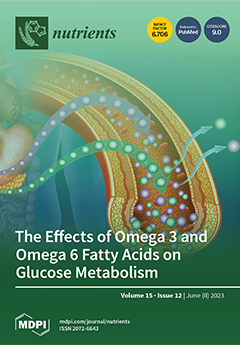Supplemental
n-3 polyunsaturated fatty acids (PUFA) on bone metabolism have yielded inconsistent results. This study aimed to examine the effects of
n-3 PUFA supplementation on bone metabolism markers and bone mineral density through a meta-analysis of randomized controlled trials. A systematic literature search was conducted using the PubMed, Web of Science, and EBSCO databases, updated to 1 March 2023. The intervention effects were measured as standard mean differences (SMD) and mean differences (MD). Additionally,
n-3 PUFA with the untreated control, placebo control, or lower-dose
n-3 PUFA supplements were compared, respectively. Further, 19 randomized controlled trials (RCTs) (22 comparisons, n = 2546) showed that
n-3 PUFA supplementation significantly increased blood
n-3 PUFA (SMD: 2.612; 95% CI: 1.649 to 3.575). However, no significant effects were found on BMD, CTx-1, NTx-1, BAP, serum calcium, 25(OH)D, PTH, CRP, and IL-6. Subgroup analyses showed significant increases in femoral neck BMD in females (0.01, 95% CI: 0.01 to 0.02), people aged <60 years (0.01, 95% CI: 0.01 to 0.01), and those people in Eastern countries (0.02, 95% CI: 0.02 to 0.03), and for 25(OH)D in people aged ≥60 years (0.43, 95% CI: 0.11 to 0.74), treated with
n-3 PUFA only (0.36, 95% CI: 0.06 to 0.66), and in studies lasting ≤6 months (0.29, 95% CI: 0.11 to 0.47). NTx-1 decreased in both genders (−9.66, 95% CI: −15.60 to −3.71), and serum calcium reduction was found in studies lasting >6 months (−0.19, 95% CI: −0.37 to −0.01). The present study demonstrated that
n-3 PUFA supplementation might not have a significant effect on bone mineral density or bone metabolism markers, but have some potential benefits for younger postmenopausal subjects in the short term. Therefore, additional high-quality, long-term randomized controlled trials (RCTs) are warranted to fully elucidate the potential benefits of
n-3 PUFA supplementation, as well as the combined supplementation of
n-3 PUFA, on bone health.
Full article






